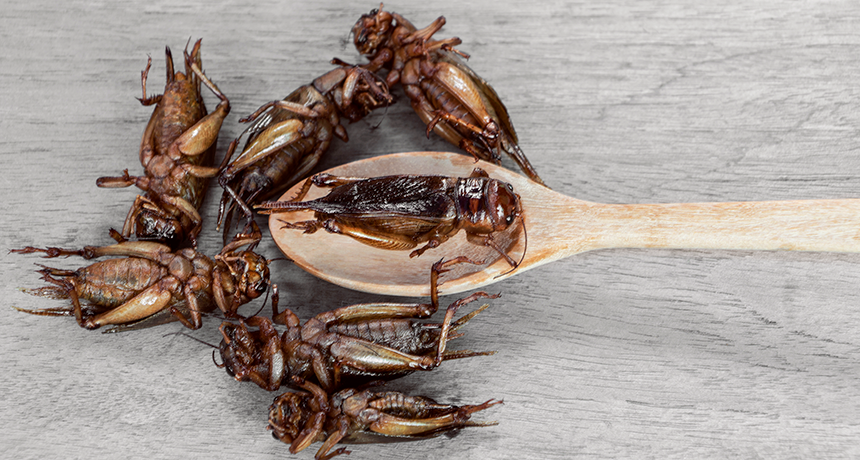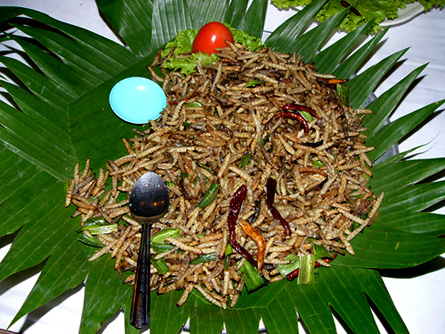Yummy bugs
Eating insects is a common practice in most places, at least outside of the United States and Europe.

In many parts of the world, people view snacking on insects, such as these, to be a great treat.
pong-photo9/iStockphoto
By Janet Raloff
This summer, the Audubon Nature Institute is opening another museum in New Orleans. Its restaurant will offer everything from soup and main courses to desserts. But the foods will contain ingredients U.S. diners would usually complain about finding on their plates: bugs.
We’re talking about grasshoppers, the worm-like larvae of wax moths, ants — even the occasional dragonfly.
Although unusual as food items, bugs do make sense here because this is the Insectarium (in sek TAIR’ ee um). As its unusual name implies, the entire museum will be devoted to the world’s six-legged species.
Want chocolate chip cookies? They’ll come topped with toasted crickets. And yes, they’re the same kind that chirp in yards and parks all summer long. Make no mistake, these bugs are not just there for looks. You’re supposed to eat them, explains Audubon chef Zack Lemann. The crickets, for instance, “taste kind of nutty,” he notes.
The restaurant will be named Bug Appétit. It’s a play on the French phrase — Bon Appétit (BOHN’ ap pay TEET’) — which means “enjoy your meal.”
Lemann and his Audubon team realize that “eewww” or “gross” may be the first reactions many people will have at seeing bugs in food. But the Audubon center hopes its visitors will leave the restaurant with a better understanding that much of the rest of the world is not turned off by bugs. Indeed, bugs are eaten by choice. What’s more, many insects are actually quite nutritious.
Why not eat bugs?
In America and Europe, most people accept crustaceans such as crab, lobster, and shrimp as food items. In fact, diners often view these foods as special, tending to pay far more for them than for chicken, pork and most beef, or serving them on special occasions. Yet crustaceans are “the ocean equivalent of insects,” says David Gracer.
In fact, crustaceans belong to the same part of the animal family tree as insects do.
When people argue that eating grasshoppers or beetle larvae is yucky, Gracer points out that lobsters tend to “eat trash and dead things.” And Insects? Most of them dine at nature’s salad bars. Knowing that, he asks, “Which would you rather eat?”

Besides pointing out that insects are good food, Gracer also argues that insects can be “a better choice” than most meats — at least ecologically.
It takes a lot of natural resources — land, water, feed and energy — to create a pound of beef or chicken. Those resources are not only costly, but can also be damaged or polluted by livestock operations. By contrast, insects can be grown on low-quality plants — even weeds, sometimes — and often using little water.
The environmental resources associated with bringing every pound of insect protein to market, therefore, are far fewer than for an equivalent amount of regular meat.
That’s why Gracer argues that “cows and pigs are the SUVs of the food world. And bugs — they’re the Priuses, maybe even bicycles.”
Good for the body
The muscle tissue in conventional livestock — such as cattle, hogs, chicken, and fish — is what we think of as meat. It’s made primarily of protein. By eating protein, we give our bodies a nutrient needed to build structural materials, including muscle.
Insects are tiny animals. And studies have shown that their protein typically has higher quantities of minerals and vitamins than occur in many conventional meats that people eat. That finding was a surprise to Sandra G.F. Bukkens, an independent nutrition scientist based in Barcelona, Spain. While she was working in Italy, several years back, she was asked to survey what scientists around the world had published on the nutritional value of bugs.
“I was pleasantly surprised,” she reports. “Insects were far more healthy than I expected.”
Gene R. DeFoliart isn’t surprised by Bukkens’ assessment. His research over the years has shown that the protein in insects tends to be at least as nutritious as that in conventional livestock meats. Sometimes, the insect protein is even better, he says. DeFoliart is an entomologist (en toh MOL’ oh jist), a scientist that studies insects. Although now retired, he worked at the University of Wisconsin–Madison for many decades.
His studies have shown that people throughout much of the world eat insects. Many cultures have eaten them for thousands of years. Although many people in wealthy Asian nations, like Japan, will snack on certain bugs, most insect dining takes place in poorer countries. Insects are popular, for instance, throughout India, much of Asia and Africa, and in South America’s rural populations.
In Mexico, however, insect dining remains common among all classes of people. As a result, insects can be purchased from street stalls or at expensive five-star restaurants, says Julieta Ramos-Elorduy of the National Autonomous University in Mexico City. Indeed, she notes, “I served them at my daughter Mariangela’s engagement party.” And from adults to small children, everyone ate her insect-laden foods, Ramos-Elorduy recalls.
Then again, Ramos-Elorduy knows how to make such meals especially tasty. Over the years she has collected recipes, tried them out, and packaged the best in a picture-filled cookbook, Creepy Crawly Cuisine: The Gourmet Guide to Edible Insects.
Most insects are eaten before they become adults, she told Science News for Kids. The reason: “Their nutritional value is greater, because they have not wasted nutrients while forming such things as wings.” In some instances, people eat the eggs of insects. More frequently, people eat the grub or caterpillar stage of butterflies, beetles and moths. Even young bees, ants and wasps may be added to improve the nutritional quality of food. Altogether, she’s found, some 1,700 different species of insects are eaten in Mexico.
Mini livestock
Until recently, most people interested in insects have collected their own. Kids in central Africa may nibble on ants or grubs while out playing. Aborigines in Australia’s Outback may travel long distances to find and picnic on honey ants. And some families in Ecuador wait for the spring rainy season to collect scarab beetles. That’s when the adult insects crawl out of the soil. People then fry the beetles with some spices or add them to flavor rice.
As people have been moving from rural areas into cities, it’s become harder for them to collect the insects their communities may have eaten for centuries. So hunters in country villages have begun collecting bugs and shipping them off to distant food markets.
For example, mopane (moh PAH’ nee) worms are eaten throughout central and southern Africa. These are not true worms, but caterpillars of a moth that lays its eggs on mopane trees. The number of people who want to eat this bug is so large that biologists have begun worrying these insects might be harvested to extinction. Sales in just one country, South Africa, can exceed 1,600 metric tons per year, DeFoliart notes.
Scientists in Thailand have found one solution to overhunting wild bugs: They’ve begun farming insects. Crickets are the one they raise most. At a United Nations meeting in Thailand earlier this year, Yupa Hanboonsong of that country’s Khon Kaen University described the situation.
In less than 10 years, nearly 20,000 Thai families have taken up cricket farming, she reported. A “farm” may consist of just a few cement cylinders, topped with window-screening material. Together, 400 families can produce up to 10 tons of crickets per month in the summer. That’s the peak season. And it’s profitable. Each family can earn $100 to $1,500 per month. Each crop of bugs will eventually be shipped to food markets in big cities throughout Southeast Asia.
Soon, Hanboonsong says, her university plans to teach local families how to farm two other popular food insects — ants and giant water bugs.
Bugfree bugs
Still not convinced that insects are a food for you? Well, scientists at Wageningen University in the Netherlands have an alternative. They are growing cells from several different types of insects, including silk worms and gypsy moths, in large vats of liquid. It’s a type of biotechnology operation that produces isolated cells, but no actual bugs.
The goal, explains Marjoleine C. Verkerk, is to produce a clean source of bug proteins that can be dried and added to breads or perhaps molded into pseudo-burgers.
Indeed, this biotech project may overcome two major obstacles that appear to stand in the way of Americans and Europeans accepting insects as a food source, says Patrick B. Durst. He works for the United Nations Food and Agriculture Organization in Bangkok. He also organized the conference on edible bugs earlier this year. The first advantage of the Dutch approach to growing cells only is that the cells will be sanitary. So people don’t have to worry about the potential of bugs to host germs. It also eliminates any chance a bug would have picked up pollutants in the field.
Even more importantly, Durst says, raising isolated insect cells avoids the gross factor — Westerners having to “look the bug in the eye as they’re eating it.”
So, would you consider eating muffins fortified with cricket cells? What if the muffin wrapper merely said the baked goods contained animal protein? These are the kinds of questions Verkerk has been asking people.
She’s investigating how to make insect cells sound appetizing to Europeans. So far, she’s found, it’s still a tough sell.







